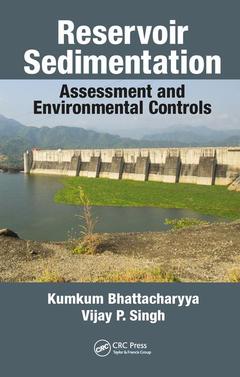Reservoir Sedimentation Assessment and Environmental Controls
Auteurs : Bhattacharyya Kumkum, Singh Vijay P.

Reservoir Sedimentation: Assessment and Environmental Controls appraises the issues of sedimentation in reservoirs and discusses measures that can be employed for the effective management of sediment to prolong the operational life of reservoirs. It provides information for professional consultants and policymakers to enable them to manage dams in the best possible way, in order to ensure their sustainability as well as the sustainability of water resources in general. It examines the effects of anthropogenic intervention and management of sediment in dams and reservoirs, as water resources become more sensitive and the demand for clean water continues to increase.
Features:
- Examines the issue of sedimentation in dams and reservoirs and presents water management strategies to alleviate environmental issues
- Presents methods to help ensure the environmental sustainability of dams and reservoirs, as well as the sustainability of water resources- with consideration of climate change and increased demand
- Illustrates the spatial distribution of sedimentation characteristics for several dams using geographic information systems (GIS)
- Explains the relationships between loss in capacity and catchment characteristics
- Examines regional variation in sediment yield, defines geomorphic regions on the basis of similar hydrometeorology, physiography, geology, and vegetation affecting reservoirs
Dr. Kumkum Bhattacharyya obtained her Ph.D. degree in 2000, and did post-doctoral research at the University of California Berkeley (2002-2003) where she worked on sediment management in aging reservoirs. She has been involved in research on “Human-Environment Interactions and Changing Fluvial Landscape in the age of the Humans” for over two decades. She has been engaged in several projects, including “The Humans Transforming the Fluvial Landscape into Hybrid Landscape,” “Preparing Damodar River Watershed for Large-scale Change,” and “Participatory Resource Management Involving Riparian Communities.” She published a book entitled “The Lower Domodar River, India: understanding the human role in changing fluvial environment,” in 2011 (Springer). She has been involved in teaching at Washington State University as well as collaborating with several professors, researchers, and engineers as well as with organizations/institutions in India and USA.
Professor V.P. Singh is a University Distinguished Professor, a Regents Professor, and the inaugural holder of the Caroline and William N. Lehrer Distinguished Chair in Water Engineering in the Department of Biological and Agricultural Engineering and Zachry Department of Civil Engineering at Texas A&M University. He received his B.S., M.S., Ph.D. and D.Sc. degrees in engineering. He is a registered professional engineer, a registered professional hydrologist, and an Honorary Diplomate of American Academy of Water Resources Engineers. He has published more than 910 journal articles; 25 textbooks; 60 edited reference books, including the Encyclopedia of Snow, Ice and Glaciers, and the Handbook of Applied Hydrology; 104 book chapters; 314 conference papers; and 72 technical reports in the areas of hydrology, ground water, hydraulics, irrigation engineering, environmental engineering, and water resources. For his scientific contributions to the development and management of wate
Date de parution : 01-2019
15.6x23.4 cm
Disponible chez l'éditeur (délai d'approvisionnement : 14 jours).
Prix indicatif 223,58 €
Ajouter au panierThèmes de Reservoir Sedimentation :
Mots-clés :
Tamil Nadu; Water Spread Area; Reservoir Sedimentation; Groundwater Depletion; Sediment Yield; Sedimentation Hot Spots; Elephant Butte Reservoir; Reservoir Storage Space; Damodar River; Western Ghats; Sediment Flux; Sediment Management; Sabo Dams; Live Storage Capacity; Annual Sediment Load; Sediment Management Strategies; Soil Management; Dam Removal; Estimate Sediment Yield; Sediment Routing; Utah Divisions; Sedimentation Surveys; Trap Efficiency; Drawdown Flushing; Hotelling Principle



